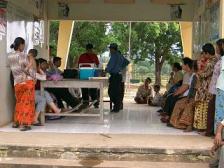| Information technology, telemedicine | ||
Telemedicine project improving health in rural CambodiaPaul Heinzelman, MD MPH, Operation Village Health Project Leader, Partners Telemedicine Summary
These consultations are based on text and image-rich clinical documents composed by Cambodian health workers, which are then emailed to physicians in Boston and in Phnom Penh. Clinical recommendations are returned to the health workers within hours of their receipt via email, allowing underserved villagers to receive better care, and providing local clinicians the opportunity to strengthen their knowledge. Since its inception, approximately 700 telemedicine-supported patient encounters have been completed. Operation Village Health is the 2006 winner of the international Stockholm Challenge in the category of Health. Recent studies demonstrate a diminishing rate of referral to facilities outside the village and a decrease in the duration of chronic medical problems among villagers. A randomized survey of patients demonstrated that they are satisfied with the telemedicine service and that most are willing to pay an average of $0.63 per visit. Overall, this initiative seeks to provide more effective and more affordable local care for these underserved villagers, and serve as a sustainable model of telemedicine-supported healthcare. The integration of new mobile technology (digital pen) and the use of web-based clinical data storage are part of future goals. Introduction Cambodia ranks among the lowest of countries on the human development index and among the highest in terms of poverty. Disparities in health care access are great – particularly in rural areas where approximately 40% live below the poverty threshold and health worker shortages prevail. The prevalence of infectious diseases and the growing problem of chronic disease are forcing Cambodia to face a significant health burden in the future. Since 1992, American Assistance for Cambodia has been working to revitalize this country after the reign of the Khmer Rouge in the late 1970s that resulted in the death of approximately two million people. Through these efforts, a growing Internet infrastructure is accompanying the broad construction of elementary schools throughout the rural countryside. Project design and Implementation Operation Village Health represents a health application for a larger initiative known as Village Leap, a program established by Japan Relief for Cambodia / American Assistance for Cambodia, a non-governmental organization devoted to fostering development by bringing technology to rural Cambodia. The mission of the organization is to rehabilitate Cambodia in the aftermath of the Khmer Rouge reign and the Vietnam War. Village Leap has been responsible for providing Internet access in nearly one third of the school facilities, using solar and generator-powered satellite dishes, wireless technology and mobile systems that receive and transmit data. In the Ratanakiri province for example, the network relies on an Internet access hub in the capital Banlung, wireless solar-powered computers, and motorcycles equipped with a data storage device, a wireless transmitter card, and an antenna. Each morning five motorcycle couriers known as ‘motomen,’ download email in Banlung addressed to villagers across the province. Travelling over rutted, red dirt roads they deliver the mail using their wireless transmitters to connect with the solar-powered computers in the small village schools. Simultaneously, the transmitters upload the outgoing mail for transmission later in the day from Banlung. Using the connectivity and network built by Village Leap, Operation Village Health has integrated technology into local healthcare delivery by supporting village health workers, building local capacity and providing care to people who otherwise would not have access to medical expertise.
To leverage this growing Internet infrastructure for health purposes, an email-based telemedicine program was established in 2001. Through this program established by Partners Telemedicine, Harvard-affiliated physicians provide clinical recommendations to Cambodian health workers caring for patients at a health centre in the village of Rovieng and a referral hospital in the town of Banlung. These consultations rely on image-rich clinical documents composed by Cambodian physicians and nurses that are emailed to physicians in Boston and in Phnom Penh for review. These consultant physicians are specialists in a variety of fields of medicine who voluntarily review the cases and return them to the health workers within hours, allowing underserved villagers to receive improved care while educating the local clinicians in appropriate medical practice. Progress and Impact Through telemedicine links, Operation Village Health bridges the cultural and digital divide allowing healthcare to make its way to rural Cambodia through a simple application of technology. Since 2001, Operation Village Health telemedicine clinics have made substantial progress in their intended mission of delivering high quality health care to local villagers in the Rovieng village in the Preah Vihear province, (N Cambodia), and in the town of Banlung in Ratanakiri province (NE Cambodia). Since its inception, approximately 700 telemedicine-supported patient encounters have been completed.
A retrospective case review studying the first 28 months of consultations documented significant transformation in local health care access. When the telemedicine clinics began seeing patients, the average duration of chief complaints at initial patient visits was 37 months, reflecting scarce access to health care in the area. By the end of the second year of operation, average chief complaint duration decreased from 37 months to 8 months, a significant reduction. Referrals to hospitals outside of the village also decreased over the 28 month study period, due to improvements in local health care worker’s skills and management techniques as well as the development of enhanced clinic capabilities that made it unnecessary for patients to travel to the distant hospital for certain basic tests. Overall, the percent of transfers to facilities out of the village dropped by 51% per year of clinical presence.
Importantly, a randomized survey of patients revealed each was “very satisfied” or “satisfied” with the care they received. None reported being “neither satisfied nor dissatisfied,” “dissatisfied,” or “very dissatisfied.” Seventy-eight percent of the patients reported they would be willing to pay for a visit at the clinic, further indicating satisfaction with the care delivered. In another retrospective case review currently underway, data from the past one and a half years will be used to guide further improvements in services provided to local villagers. The feasibility of important public health initiatives such as preventive health services and screening for prevalent diseases is also being investigated as a critical future step. New Technologies A major obstacle to smooth exchange of information between the US and Cambodia is the collection, transcription and completeness of clinical data. A focus group of participating Operation Village Health Cambodian physicians identified time-intensive keyboard transcription for the creation of English language documents as a significant interruption to the usual clinical workflow that required 50% of the total time devoted to the telemedicine-supported encounters. Additionally, feedback from US consulting specialists noted that incomplete clinical documentation by local health workers was limiting their ability to respond with definitive recommendations. These obstacles, amplified by cultural and language differences, inhibit broader adoption among Cambodian health workers and threaten the ultimate sustainability and scalability of this otherwise successful program. In response to these challenges, a number of technologies and clinical tools were reviewed and assessed for applicability to the Operation Village Health model. Digital pen technology, in conjunction with pro-forma clinical templates, was proposed as a cost-effective model with low cost of implementation and adoption, which will be easily integrated into the workflow of the program. Advantages of the digital pen technology solution include:
Future directions Through assessment of the existing program, we have identified future targets for improving current operations and initiating new clinical sites. Program improvements have already included the introduction of a basic point-of-care laboratory and the development of simple clinical guidelines for the ten most commonly encountered medical problems, allowing local clinicians to manage their patients more confidently and independently. Digitally-enhanced pen and paper clinical forms are now being piloted for their potential to standardize the locally-created clinical documents, and improve efficiency of this program. In addition, direct integration of these clinical documents into an existing Partners HealthCare web portal and database will allow more effective tracking of the health status of these communities. To date, this project has been financially supported by donations made from corporations, foundations and individuals. Future plans for this project rely on the donations from these sources. Consulting physicians at Partners HealthCare provide their time on a voluntary basis. Overall, Operation Village Health seeks to establish a platform for effective and affordable local care for underserved villagers and emphasizes self-sufficiency. Over the next three years we aim to validate its value by demonstrating that it is not only feasible, but sustainable and scalable as well. Our belief is that this program may ultimately serve as a model for cross-cultural telemedicine initiatives in other remote settings of the developing world.
Link Partners Telemedicine |

